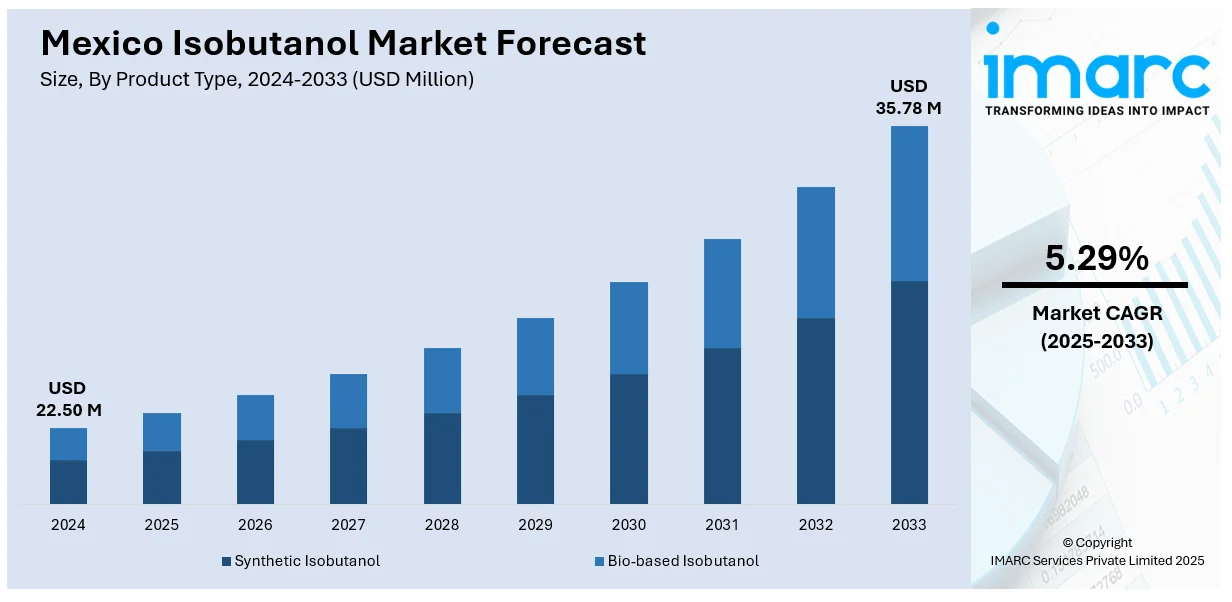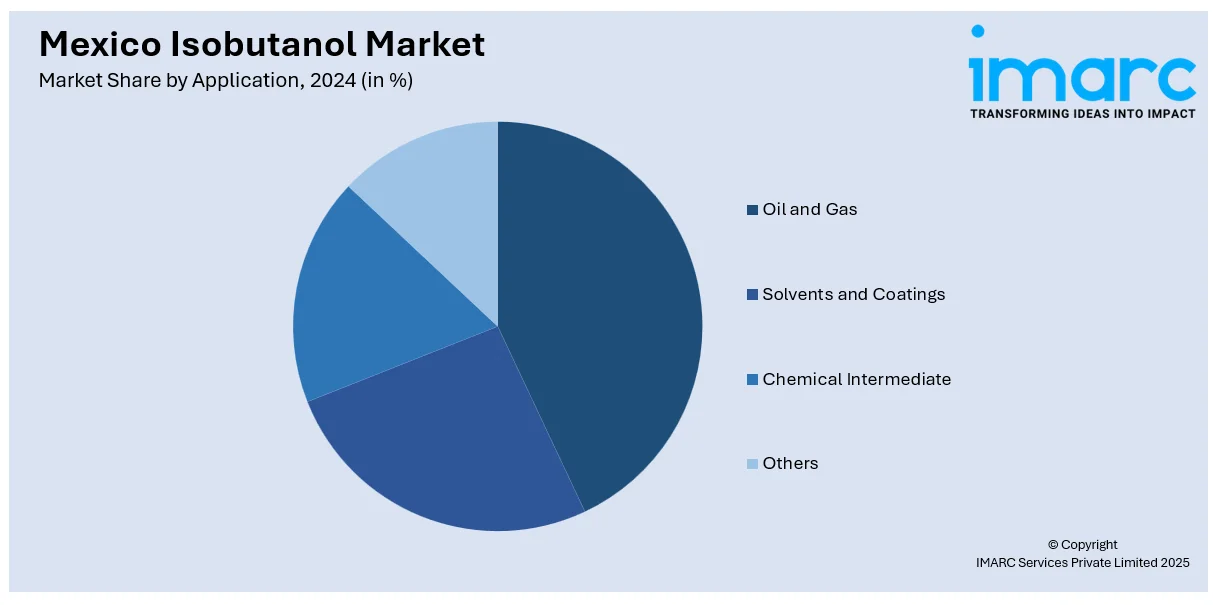
Mexico Isobutanol Market Size, Share, Trends and Forecast by Product Type, Application, and Region, 2025-2033
Mexico Isobutanol Market Overview:
The Mexico isobutanol market size reached USD 22.50 Million in 2024. Looking forward, IMARC Group expects the market to reach USD 35.78 Million by 2033, exhibiting a growth rate (CAGR) of 5.29% during 2025-2033. The growing innovations in the automotive and industrial sectors are offering a favorable market outlook. The Mexican government is also enhancing policies and regulations that support the adoption of biofuels and renewable energy. Apart from this, increasing consciousness about environmental concerns is expanding the Mexico isobutanol market share.
|
Report Attribute
|
Key Statistics
|
|---|---|
|
Base Year
|
2024 |
|
Forecast Years
|
2025-2033
|
|
Historical Years
|
2019-2024
|
| Market Size in 2024 | USD 22.50 Million |
| Market Forecast in 2033 | USD 35.78 Million |
| Market Growth Rate 2025-2033 | 5.29% |
Mexico Isobutanol Market Trends:
Increasing Demand for Isobutanol in Automotive and Industrial Applications
Mexico's isobutanol sector is experiencing rapid growth due to the escalating demand for the chemical in the automotive and industrial industries. Isobutanol is applied by manufacturers as a key constituent in the production of fuels, solvents, and coatings. The expanding innovations in the automotive industry, propelled by the increased need for fuel efficiency and demand for green options, is also promoting the consumption of isobutanol for biofuels. Additionally, isobutanol is utilized in industrial applications such as paints, coatings, and adhesives due to its superior performance in terms of being a solvent. The adaptability of the chemical to reduce emission of harmful compounds and improve the quality of the product is motivating manufacturers to incorporate isobutanol in most of their products. With the growing innovations in the industrial sector in Mexico, these trends are catalyzing the demand for isobutanol in industrial and automotive use.

Growing Awareness and Preference for Green Products
Increasing consciousness regarding environmental concerns is contributing to the Mexico isobutanol market growth. With people increasingly becoming environmentally conscious regarding the environmental cost of products they consume, a shift towards eco-friendly and sustainable options can be witnessed. Isobutanol, being a bio-based chemical, is increasingly being preferred for its lower environmental burden than conventional petroleum-based chemicals. This change in demand is encouraging Mexican companies to invest in eco-friendly production processes and implement isobutanol in their formulations. The need for green products in applications, such as personal care, cleaning products, and food and beverages, is also driving the market. With people giving more emphasis to environment friendly options, the demand for isobutanol is rising. The IMARC Group predicts that the Mexico beauty and personal care industry size is presumed to reach USD 17.6 Billion by 2033.
Government Support for Biofuels and Renewable Energy
The Mexican government is issuing policies and regulations that support the adoption of biofuels and renewable energy, significantly driving the demand for isobutanol. National initiatives are focused on reducing greenhouse gas emissions and promoting energy sustainability, which is leading to an increase in the use of bio-based chemicals like isobutanol in renewable fuels. With the government providing incentives for sustainable practices, such as tax breaks and subsidies for renewable energy projects, companies in Mexico are increasingly investing in isobutanol production to meet rising fuel demand. This supportive environment is encouraging both domestic and international players to strengthen their presence in Mexico’s renewable energy market, particularly within the biofuel segment. As regulatory frameworks evolve to prioritize environmental sustainability, the role of isobutanol as an eco-friendly alternative to traditional fuels is becoming more prominent in the Mexican market. In 2024, Claudia Sheinbaum presented her vision to promote clean energy and improve investment in the infrastructure sector. In her 100 government commitments, she included the heightened reliance on renewable energy with a major plan of 45% share of the sector by 2030. She also laid out her plan to promote photovoltaic panels to power households, thereby lowering electric requirements and environmental impacts.
Mexico Isobutanol Market Segmentation:
IMARC Group provides an analysis of the key trends in each segment of the market, along with forecasts at country and regional levels for 2025-2033. Our report has categorized the market based on product type and application.
Product Type Insights:
- Synthetic Isobutanol
- Bio-based Isobutanol
The report has provided a detailed breakup and analysis of the market based on the product type. This includes synthetic isobutanol and bio-based isobutanol.
Application Insights:

- Oil and Gas
- Solvents and Coatings
- Chemical Intermediate
- Others
A detailed breakup and analysis of the market based on the application have also been provided in the report. This includes oil and gas, solvents and coatings, chemical intermediate, and others.
Regional Insights:
- Northern Mexico
- Central Mexico
- Southern Mexico
- Others
The report has also provided a comprehensive analysis of all the major regional markets, which include Northern Mexico, Central Mexico, Southern Mexico, and others.
Competitive Landscape:
The market research report has also provided a comprehensive analysis of the competitive landscape. Competitive analysis such as market structure, key player positioning, top winning strategies, competitive dashboard, and company evaluation quadrant has been covered in the report. Also, detailed profiles of all major companies have been provided.
Mexico Isobutanol Market Report Coverage:
| Report Features | Details |
|---|---|
| Base Year of the Analysis | 2024 |
| Historical Period | 2019-2024 |
| Forecast Period | 2025-2033 |
| Units | Million USD |
| Scope of the Report | Exploration of Historical Trends and Market Outlook, Industry Catalysts and Challenges, Segment-Wise Historical and Future Market Assessment:
|
| Product Types Covered | Synthetic Isobutanol, Bio-based Isobutanol |
| Applications Covered | Oil and Gas, Solvents and Coatings, Chemical Intermediate, Others |
| Regions Covered | Northern Mexico, Central Mexico, Southern Mexico, Others |
| Customization Scope | 10% Free Customization |
| Post-Sale Analyst Support | 10-12 Weeks |
| Delivery Format | PDF and Excel through Email (We can also provide the editable version of the report in PPT/Word format on special request) |
Key Questions Answered in This Report:
- How has the Mexico isobutanol market performed so far and how will it perform in the coming years?
- What is the breakup of the Mexico isobutanol market on the basis of product type?
- What is the breakup of the Mexico isobutanol market on the basis of application?
- What is the breakup of the Mexico isobutanol market on the basis of region?
- What are the various stages in the value chain of the Mexico isobutanol market?
- What are the key driving factors and challenges in the Mexico isobutanol market?
- What is the structure of the Mexico isobutanol market and who are the key players?
- What is the degree of competition in the Mexico isobutanol market?
Key Benefits for Stakeholders:
- IMARC’s industry report offers a comprehensive quantitative analysis of various market segments, historical and current market trends, market forecasts, and dynamics of the Mexico isobutanol market from 2019-2033.
- The research report provides the latest information on the market drivers, challenges, and opportunities in the Mexico isobutanol market.
- Porter's five forces analysis assist stakeholders in assessing the impact of new entrants, competitive rivalry, supplier power, buyer power, and the threat of substitution. It helps stakeholders to analyze the level of competition within the Mexico isobutanol industry and its attractiveness.
- Competitive landscape allows stakeholders to understand their competitive environment and provides an insight into the current positions of key players in the market.
Need more help?
- Speak to our experienced analysts for insights on the current market scenarios.
- Include additional segments and countries to customize the report as per your requirement.
- Gain an unparalleled competitive advantage in your domain by understanding how to utilize the report and positively impacting your operations and revenue.
- For further assistance, please connect with our analysts.
 Request Customization
Request Customization
 Speak to an Analyst
Speak to an Analyst
 Request Brochure
Request Brochure
 Inquire Before Buying
Inquire Before Buying




.webp)




.webp)












